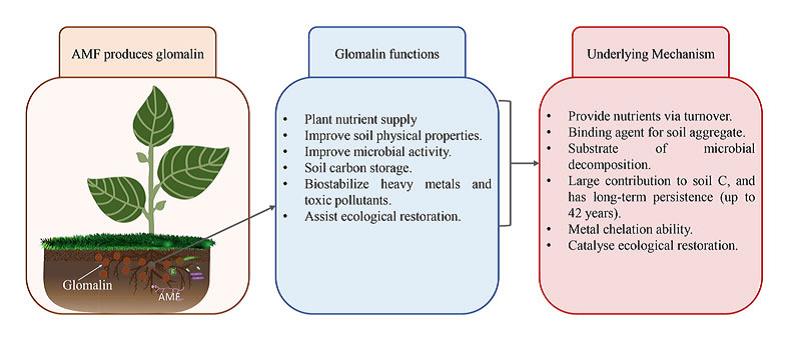Rising global population and anthropogenic activities increase tremendous pressure on soil for the production of crops and other kinds of biomass. Soil degradation are not only linked to agriculture intensification and over-exploitation of nutrients of soil but also caused by multiple pollutants from various anthropogenic sources discharge on land.
Glomalin, an arbuscular-mycorrhizal fungal soil protein, also contributes to the mitigation of soil degradation. However, to date, the role of glomalin in the amelioration of soil degradation problems and the underlying mechanisms are not well known and summarized.
In a study published in Critical Reviews in Environmental Science andTechnology, researchers from Xishuangbanna Tropical Botanical Garden (XTBG) systematically compiled and comprehensively literature reviewed each function of glomalin in the context of soil degradation. Specifically, they covered the glomalin’s role in soil physical properties, nutrients cycling, soil carbon (C) storage, microbial activity, remediation of pollutants, and ecological restoration.
The researchers highlighted that glomalin contributes to multiple soil functions, including conditioner of soil physical properties, nutrients supply, carbon storage, microbial substrate, biostabilize heavy metal and toxic organic pollutants, and catalyze ecological restoration.
According to the review, glomalin improves soil physical properties such as bulk density, porosity, water holding capacity, and control soil erosion by reducing soil runoff losses. By improving soil physical, chemical, and biological properties, glomalin can help restore degraded lands and possesses the ability to chelate toxic heavy metals and pollutants.
Glomalin production in soil relies on synergistic interaction among plant, soil, and AMF. Therefore, “specific or combined strategies are needed at the plant, soil, and AMF level to improve glomalin concentration in soil,” said Dr. Ashutosh Kumar Singh of XTBG.
To improve glomalin concentration, the researchers suggested developing genetically modified or hybrid plants for higher rhizodeposition and promoting soil microbial diversity through the inoculation of arbuscular mycorrhizal fungi (AMF) and beneficial bacteria.
“This review can improve our understanding of glomalin, stimulate future research, and be useful for the sustainable restoration of degraded lands,” said Prof. LIU Wenjie, principal investigator of the study.
Contact
LIU Wenjie Ph.D Principal Investigator
Key Laboratory of Tropical Forest Ecology, Xishuangbanna Tropical Botanical Garden, Chinese Academy of Sciences, Mengla, Yunnan 666303, China
E-mail: lwj@xtbg.org.cn

The role of glomalin in mitigation of multiple soil degradation problems (Image by Ashutosh Kumar Singh)

